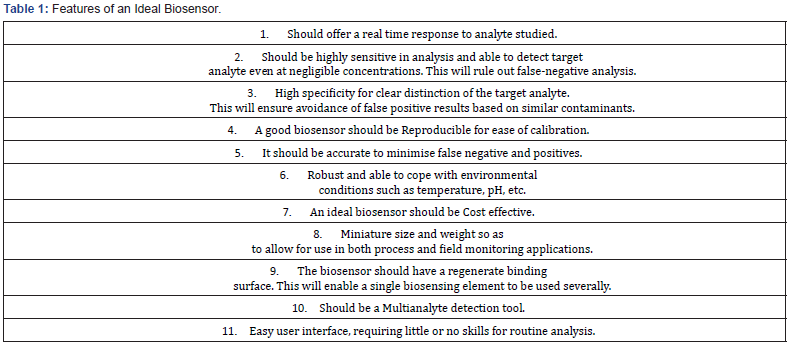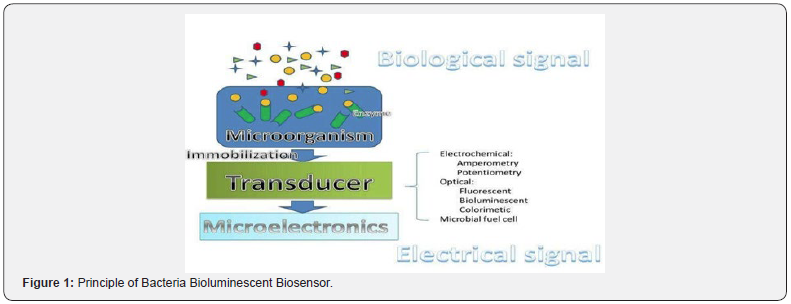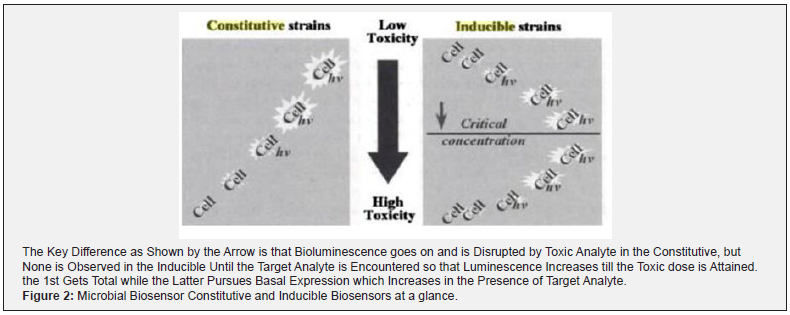Bacterial Bioluminescent Biosensors: Principle and Applications
Chidiebele EI Nwankwo1,2*, Vincent N Chigor2,3 and Nedie P Akani4
1Water and Public Health Research Group (WPHRG), Nigeria
2Natural Science Unit, School of General Studies, Nigeria
3Department of Microbiology, University of Nigeria, Nigeria
4Department of Microbiology, Rivers State University, Nigeria
Submission: October 14, 2019; Published: November 13, 2019
*Corresponding author: Chidiebele EI Nwankwo, Water and Public Health Research Group (WPHRG), Natural Science Unit, School of General Studies, Nigeria
How to cite this article: Chidiebele EI Nwankwo, Vincent N Chigor, Nedie P Akani. Bacterial Bioluminescent Biosensors: Principle and Applications. Adv Biotechnol Microbiol. 2019; 15(1): 555901. DOI: 10.19080/AIBM.2019.14.555901
Abstract
Numerous hazardous contaminants with detrimental effects a replete in the ecosystem. Bacterial Bioluminescent Biosensors offer an easy and reliable method for monitoring these contaminants towards environmental remediation. These biosensors respond to analyte either constitutively or inducibly on a non-specific or specific basis respectively. Either way, they offer a reliable method for detection and biological interpretation toxicants. Their responses are recorded in terms of bioluminescence; a physiological function that will change variously in response to a toxicant. Bacterial bioluminescent biosensors have been successfully deployed in various areas of science including environmental monitoring and in the food industry.
Keywords: Bacterial bioluminescent biosensor; Contaminants; Bioavailability; Toxicant; Remediation
Introduction
A notable consequence of the global industrial revolution is the contamination of the ecosystem. This has become worse as numerous anthropogenic activities have placed the ecosystem at the receiving end of numerous contaminants. These contaminants are with severe consequences on the environment and inhabiting biota, including man. Presently, the ecosystem threatens to haunt man as a result of severe degradation. This explains numerous global efforts towards ecosystem restoration and preservation. The successful reclamation of the contaminated ecosystem relies heavily on initial assessment of extent of contamination [1,2]. The effective assessment of contaminated sites rely on choice of tools used. Although an understanding of level of contamination is important, estimating the bioavailable fraction is key [3]. Most chemical methods define the bioavailable fraction of a contaminant but fail to interpret in the biological sense [4]. The introduction of biological measurements and peculiar environmental parameters are important in hazard/risk analysis because they reflect the functionality of ecological processes in these environments [1,5]. Biological models such as earthworms and other invertebrates have been used for environmental assessment [3]. However, microorganisms such as bacteria are preferred due to their high sensitivity, low cost, ability to perform in a range of pH and temperature as well as ease of application [6,7]. described microorganisms as unequalled in gene expression and physiology study of complex environments, providing accurate response on various contaminants from a biological standpoint. Biosensors have been extensively applied in health, agriculture, food industries and environmental studies [8-10]. This short review presents a brief into the principle of operation of the bacterial bioluminescent biosensor and further displays their applications in key scientific areas.
The principle of bacterial bioluminescent biosensor
A biosensor is an integrated analytical device that uses biological recognition element, mostly biomolecules, to bind an analyte or contaminant [8,9]. The binding event is captured by a transduction mechanism measured in terms of bioavailable fraction of the analyte [11,12]. Biosensors are cheap, rapid, selective and usually specific. Based on various criteria, biosensors may be classified as affinity and catalytic based on the activities of the biorecognition elements [12]. They may be classified (based on biorecognition element used) into enzyme, cofactor, nucleic acid, antibody receptors, organelle, tissues, cells, molecular imprinted polymers, liposomes as well as microbial biosensors [12,13]. reported that the choice of biological response agent depends on analyte, specificity, storage and environmental stability.
Microbial biosensor immobilizes microorganisms on a transducer for the detection of analytes. Although several microorganisms could be used as microbial biosensors, bacteria is preferred as they are major constituents of various environmental biotic community and control most ecosystem functions in terms of biogeochemical cycling [3]. Whole-cell bacterial biosensors usually operate on the principle of bioluminescence and may be constitutively expressed (bioluminescent in the absence of the toxicant) or inducible (bioluminescent in the presence of a specific substrate) (Table1). Several bacterial biosensors with varying detection limits have been developed and successfully applied [7]. The detection limits of the bioluminescent biosensors are range from rather negligible levels to very high contaminant concentrations [8].

Just like ability to code for a given protein confers certain functions to various organisms, bacteria is only able to survive a polluted environment if it is able to encode a resistance system [7]. This is a great plus in the constitution of biosensors (Figure 1). Bioluminescent sensing involves detecting change in luminescence emitted by the bacteria in response to a target analyte in a dose dependent manner. The luciferase coded by the lux gene catalyses the oxidation of Flavin Mononucleotide (FMNH2) and a long chain fatty aldehyde to emit of blue-green light. It provides a faster and more sensitive detection than fluorescence since bioluminescence is a measure of enzyme activity instead of protein quantification. Other advantages include no need for external substances as all reactants are produced in vivo and lux gene, may be inducibly or constitutively controlled [11] (Figure 2).


Applications of Bacterial Bioluminescent Biosensors
Detection of environmental contaminants
Numerous contaminants such as Polycyclic Aromatic Hydrocarbons, heavy metals and crude oil, result from various anthropogenic activities. Primarily, industrial processes has led to the introduction of these contaminants to the environment. These substances are present at different levels and usually with adverse effects to the biota. The use of bacterial bioluminescent biosensors have been useful in the detection of these toxicants even at very low concentrations. More so, the detection is assessed by these sensors with a biological interpretation of the effects at once. These sensors provide a cost effective, reliable and specific assessment method for evaluation of numerous contaminants. Some bioluminescent biosensor that have been used in monitoring environmental pollution include E. coli [14], Pseudomonas sp. [15], Bacillus subtilis [16]. Studies have successfully applied these biosensors for detection and monitoring contaminants in water, soil and air environments [14,17-19].
Applications in the food industry
The food industry is a very sensitive one with high quality expectations. However, food products integrnty have been compromised severally. This has led to many adverse effects. Numerous traditional testing methods may fail to identify hazardous contaminants in food at certain low levels. Bacterial luminescent sensors have been applied to detect toxicants in food at very negligible levels. This has been applied successfully to monitor bacteria contamination and count in food [19-21]. The food industry presents with a high need for quality assurance now than ever. Biosensors offer specific and affordable methods to meet this quality assurance needs [14].
Conclusion
Bacterial bioluminescent biosensors present with numerous beneficial, desirable attributes for the monitoring and assessments. They are able to detect at negligible levels so long as the analyte is bioavailable. These biosensors have been successfully applied in various areas of science. Biotechnology could aid in the development of various biosensors for specific monitoring of analytes.
References
- Thakali S, Allen HE, Di Toro DM, Ponizovsky AA, Rooney CP, et al. (2006) A terrestrial biotic ligand model. 1. Development and application to Cu and Ni toxicities to barley root elongation in soils. Environ Sci Technol 40(22): 7085-7093.
- Abollino O, Aceto M, Malandrino M, Mentasti E, Sarzanini C, et al. (2002) Distribution and mobility of metals in contaminated sites. Chemometric investigation of pollutant profiles. Environ Pollut 119(2): 177-193.
- Maderova L, Watson M, Paton GI (2011) Bioavailability and toxicity of copper in soils: Integrating chemical approaches with responses of microbial biosensors. Soil Biology and Biochemistry 43(6): 1162-1168.
- Paton GI, Viventsova E, Kumpene J, Wilson MJ, Weitz HJ, et al. (2006) An ecotoxicity assessment of contaminated forest soils from the Kola Peninsula. Sci Total Environ 355(1-3): 106-117.
- van Gestel CA (2008) Physico-chemical and biological parameters determine metal bioavailability in soils. Science of the Total Environment 406(3): 385-395.
- Karim F, Fakhruddin ANM (2012) Recent advances in the development of biosensor for phenol: a review. Reviews in Environmental Science and Bio/Technology 11(3): 261-274.
- Gupta S, Saxena M, Saini N, Kumar R, Kumar A (2012) An effective strategy for a whole-cell biosensor based on putative effector interaction site of the regulatory DmpR protein. PloS one 7(8): e43527.
- Thacharodi A, Jeganathan C, Thacharodi D (2019) Biomonitoring of Heavy Metal Pollution by Bioluminescent Bacterial Biosensors. Indian Journal of Science and Technology 12: 15.
- Pini F, East AK, Appia-Ayme C, Tomek J, Karunakaran R, et al. (2017) Bacterial biosensors for in vivo spatiotemporal mapping of root secretion. Plant physiol 174(3): 1289-1306.
- Thouand G, Marks RS (2016) Bioluminescent microbial biosensors: design, construction, and implementation. CRC Press.
- Su L, Jia W, Hou C, Lei Y (2011) Microbial biosensors: a review. Biosensors and bioelectronics 26(5): 1788-1799.
- Griffin GD, Stratis Cullum DN (2009) Biosensors. Encycl Microbiol 88-103.
- D souza SF (2001) Microbial biosensors. Biosensors and Bioelectronics 16(6): 337-353.
- Dai C, Choi S (2013) Technology and applications of microbial biosensor. Open Journal of Applied Biosensor 2(03): 83.
- Heitzer A, Malachowsky K, Thonnard JE, Bienkowski PR, White DC, et al. (1994) Optical biosensor for environmental on-line monitoring of naphthalene and salicylate bioavailability with an immobilized bioluminescent catabolic reporter bacterium. Appl Environ Microbiol 60(5): 1487-1494.
- Tecon R, Van der Meer JR (2008) Bacterial biosensors for measuring availability of environmental pollutants. Sensors 8(7): 4062-4080.
- Daniel R, Almog R, Ron A, Belkin S, Diamand YS (2008) Modeling and measurement of a whole-cell bioluminescent biosensor based on a single photon avalanche diode. Biosens Bioelectron 24(4): 882-887.
- Hassan SH, Van Ginkel SW, Hussein MA, Abskharon R, Oh SE (2016) Toxicity assessment using different bioassays and microbial biosensors. Environ Int 92: 106-118.
- Luo J, Liu X, Tian Q, Yue W, Zeng J, et al. (2009) Disposable bioluminescence-based biosensor for detection of bacterial count in food. Anal Biochem 394(1): 1-6.
- Hamdi H, Benzarti S, Manusadzianas L, Aoyama I, Jedidi N (2007) Solid-phase bioassays and soil microbial activities to evaluate PAH-spiked soil ecotoxicity after a long-term bioremediation process simulating landfarming. Chemosphere 70(1): 135-143.
- Saurav K, Costantino V, Venturi V, Steindler L (2017). Quorum sensing inhibitors from the sea discovered using bacterial N-acyl-homoserine lactone-based biosensors. Marine drugs 15(3): 53.






























